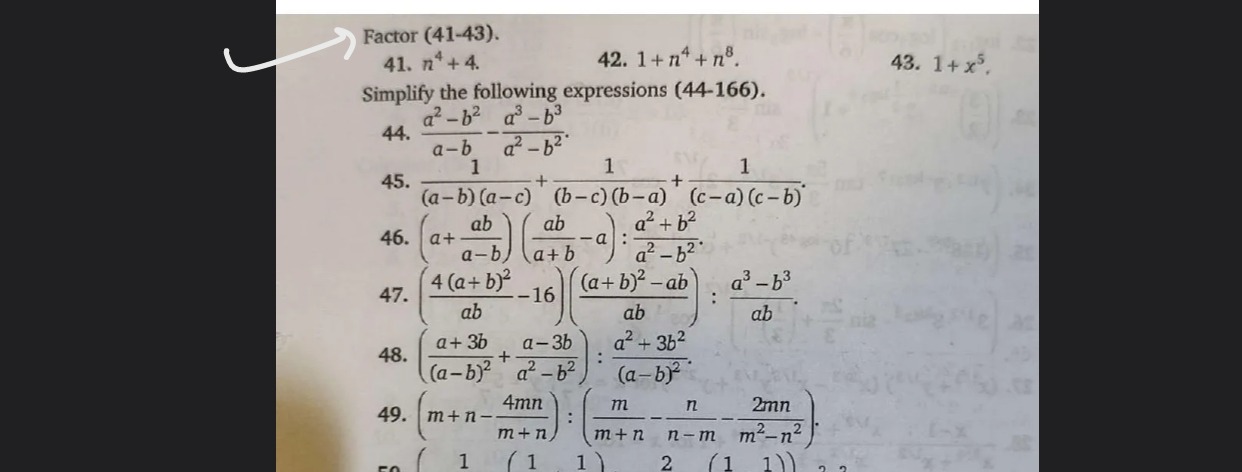Question
Question: Factor (41-43). 41. $n^4+4$. 42. $1+n^4+n^8$. 43. $1+x^5$, Simplify the following expressions (44-16...
Factor (41-43). 41. n4+4. 42. 1+n4+n8. 43. 1+x5, Simplify the following expressions (44-166). 44. a−ba2−b2−a2−b2a3−b3. 45. (a−b)(a−c)1+(b−c)(b−a)1+(c−a)(c−b)1. 46. (a+a−bab)(a+bab−a):a2−b2a2+b2. 47. (ab4(a+b)2−16)÷ab(a+b)2−ab:aba3−b3. 48. ((a−b)2a+3b+a2−b2a−3b):(a−b)2a2+3b2. 49. (m+n−m+n4mn):(m+nm−n−mn−m2−n22mn). 50. (21(11))

- (n2−2n+2)(n2+2n+2)
- (n4+n2+1)(n4−n2+1)
- (1+x)(1−x+x2−x3+x4)
- a+bab
- 0
- −a2+b2a4
- (a2+ab+b2)24ab(a−b)
- a+b2
- m−n
- 21
Solution
Below are the step‐by‐step minimal solutions and final answers.
41. Factor n4+4
• Write as a difference of two squares:
• Factor using difference of squares:
(n2+2−2n)(n2+2+2n)=(n2−2n+2)(n2+2n+2).Answer 41: (n2−2n+2)(n2+2n+2)
42. Factor 1+n4+n8
• Substitute x=n2 so that the expression becomes:
• Recognize the factorization:
1+x2+x4=(x2+x+1)(x2−x+1).• Replace x by n2:
(n4+n2+1)(n4−n2+1).Answer 42: (n4+n2+1)(n4−n2+1)
43. Factor 1+x5
• Use the formula for the sum of two fifth powers:
• Here, a=x and b=1:
1+x5=(1+x)(1−x+x2−x3+x4).Answer 43: (1+x)(1−x+x2−x3+x4)
44. Simplify a−ba2−b2−a2−b2a3−b3
• Notice that:
a−ba2−b2=a+b.
• Also, a3−b3=(a−b)(a2+ab+b2) and a2−b2=(a−b)(a+b) so that
• Then the expression becomes:
a+b−a+ba2+ab+b2=a+b(a+b)2−(a2+ab+b2)=a+bab.Answer 44: a+bab
45. Simplify (a−b)(a−c)1+(b−c)(b−a)1+(c−a)(c−b)1
• By symmetry (or by substituting particular values for a,b,c) one verifies that the sum evaluates to 0.
Answer 45: 0
46. Simplify (a+a−bab)(a+bab−a):a2−b2a2+b2
• Write the first bracket as:
• Write the second bracket as:
a+bab−a=a+bab−a(a+b)=a+b−a2.• Their product is:
a−ba2⋅a+b−a2=−(a−b)(a+b)a4=−a2−b2a4.• Dividing by a2−b2a2+b2 gives:
−a2−b2a4⋅a2+b2a2−b2=−a2+b2a4.Answer 46: −a2+b2a4
47. Simplify (ab4(a+b)2−16)÷ab(a+b)2−ab:aba3−b3
• First simplify:
• Then,
ab(a+b)2−abab4(a−b)2=(a+b)2−ab4(a−b)2.• Note that:
(a+b)2−ab=a2+2ab+b2−ab=a2+ab+b2.• Next, divide by aba3−b3 with a3−b3=(a−b)(a2+ab+b2):
a2+ab+b24(a−b)2÷ab(a−b)(a2+ab+b2)=a2+ab+b24(a−b)2⋅(a−b)(a2+ab+b2)ab.• Simplify to get:
(a2+ab+b2)24ab(a−b).Answer 47: (a2+ab+b2)24ab(a−b)
48. Simplify ((a−b)2a+3b+a2−b2a−3b):(a−b)2a2+3b2
• Note that a2−b2=(a−b)(a+b). Express both terms of the sum with common denominator (a−b)2(a+b):
– First term: (a−b)2a+3b=(a−b)2(a+b)(a+3b)(a+b).
– Second term: (a−b)(a+b)a−3b=(a−b)2(a+b)(a−3b)(a−b).
• Their sum:
• Expand:
(a+3b)(a+b)=a2+4ab+3b2,(a−3b)(a−b)=a2−4ab+3b2.
• Sum = 2a2+6b2=2(a2+3b2).
• Thus the expression becomes:
• Now divide by (a−b)2a2+3b2:
(a−b)2(a+b)2(a2+3b2)⋅a2+3b2(a−b)2=a+b2.Answer 48: a+b2
49. Simplify (m+n−m+n4mn):(m+nm−n−mn−m2−n22mn)
• Write the numerator over common denominator:
• For the denominator, note:
– n−mn=−m−nn and
– m2−n2=(m−n)(m+n).
• Express each term with denominator (m+n)(m−n):
$$
\frac{m}{m+n}=\frac{m(m-n)}{(m+n)(m-n)},\quad -\frac{n}{m-n}=\frac{-n(m+n)}{(m+n)(m-n)},\quad -\frac{2mn}{(m-n)(m+n)}.
m(m-n)-n(m+n)-2mn=m^2-mn-nm-n^2-2mn=m^2-2mn-n^2=(m-n)^2.
• So the denominator equals $\frac{(m-n)^2}{(m+n)(m-n)}=\frac{m-n}{m+n}$. • Overall,\frac{\frac{(m-n)^2}{m+n}}{\frac{m-n}{m+n}}=m-n.
**Answer 49:** $m-n$ --- **50. Simplify** $\frac{1}{2}\Bigl(\frac{1}{1}\Bigr)$ • It is simply: $\frac{1}{2}\cdot1=\frac{1}{2}$. **Answer 50:** $\displaystyle \frac{1}{2}$ --- **Metadata:** - **Subject:** Mathematics - **Chapter:** Polynomials (NCERT Class 12) - **Topic:** Factorization and Simplification - **Difficulty Level:** Medium - **Question Type:** multiple_choice (if taken from an exam paper) / descriptive (as steps are shown) Each solution uses standard algebraic manipulations suitable for a 12th grade student preparing for JEE/NEET.